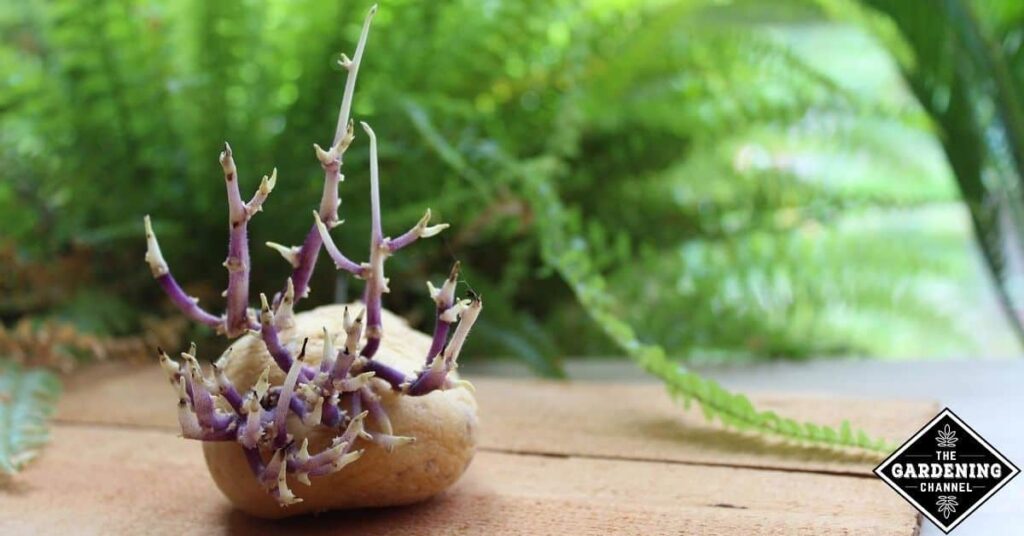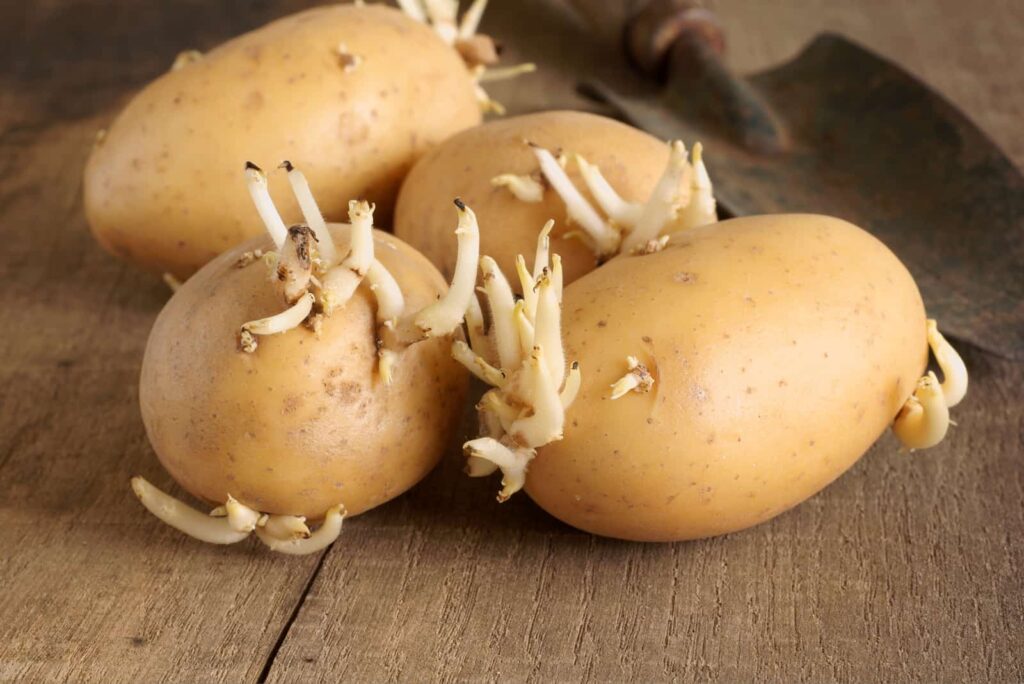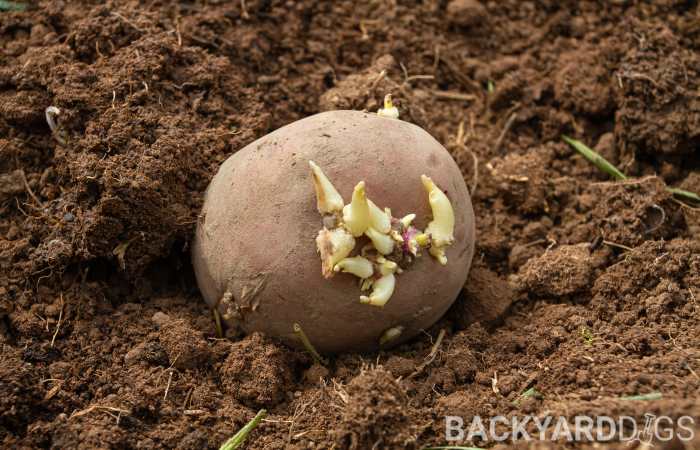This article investigates the prevalent belief that potatoes sprout faster in the dark. It aims to analyze the scientific basis behind this claim and explore the factors that contribute to potato sprouting. By examining the relationship between darkness and potato sprouting, this study sheds light on the fascinating world of plant growth and challenges common assumptions about the conditions required for sprouting. Through an exploration of experiments and scientific research, this article seeks to provide a comprehensive understanding of the connection between darkness and potato sprouting. Potatoes are a widely consumed and versatile vegetable that can be stored for extended periods. However, one common issue faced by potato growers and consumers is the sprouting of potatoes. When potatoes sprout, they become less desirable for consumption due to changes in texture, taste, and nutritional content. Understanding the factors that affect potato sprouting can help in developing strategies to control or delay sprouting, thereby improving potato storage and reducing waste. This article will discuss the various factors affecting potato sprouting, the sprouting process, the effects of darkness on potato sprouting, the role of light in plant growth, the role of darkness in plant growth, an experiment comparing potato sprouting in light and dark conditions, scientific studies on potato sprouting and light conditions, practical implications for potato storage, and conclude with key takeaways on potato sprouting control.
Factors Affecting Potato Sprouting
Potato sprouting is influenced by several factors, including temperature, moisture, light, and nutrients. These factors interact with each other, leading to variations in sprouting patterns and rates. Understanding the impact of these factors is crucial for efficient potato storage and sprouting control.
Temperature
Temperature plays a vital role in potato sprouting. Higher temperatures generally promote faster sprouting, whereas low temperatures delay sprouting. This temperature sensitivity is due to the influence of temperature on metabolic processes within the potato tubers. Cooler temperatures slow down metabolic activity, including sprout initiation, while warmer temperatures accelerate these processes. However, extreme temperatures, both high and low, can negatively affect sprouting and overall potato quality.
Moisture
Moisture content is another crucial factor affecting potato sprouting. Potatoes require a certain level of moisture for sprouting to occur. Excessive moisture can lead to rotting and disease development, while insufficient moisture may inhibit sprouting. Maintaining appropriate moisture levels is essential for preventing sprout emergence and maintaining potato quality during storage.
Light
Light exposure significantly impacts potato sprouting. Although potatoes are typically grown underground, they can be exposed to light during storage or transportation. Light can trigger sprout development and elongation, leading to premature sprouting. However, the effects of light on potato sprouting are dependent on several factors, such as light intensity, duration, quality, and the presence of chlorophyll.
Nutrients
The availability of nutrients is crucial for sprouting and overall growth of potato tubers. Adequate levels of essential nutrients, such as nitrogen, phosphorus, and potassium, promote healthy sprout development. Nutrient deficiencies or imbalances can negatively affect sprouting and lead to abnormal sprout growth. It is essential to provide a balanced nutrient supply to optimize potato sprouting and prevent nutrient-related disorders.
Potato Sprouting Process
Potato sprouting involves a series of stages, including bud initiation, bud development, sprout elongation, and leaf expansion. Understanding these stages can provide insight into the overall sprouting process and help in identifying critical control points.
Bud Initiation
Bud initiation marks the beginning of the sprouting process. It involves the activation of dormant buds present on the potato tuber. During this stage, metabolic processes within the bud cells are stimulated, preparing them for further growth and development.
Bud Development
Once initiated, the buds enter the development phase. The buds start to grow and differentiate, forming the basis for future sprouts. Cell division and elongation occur, resulting in the formation of visible sprout structures.
Sprout Elongation
Sprout elongation is the phase where sprouts grow in length. The cells in the sprout undergo rapid division and elongation, leading to visible growth. The sprouts become more pronounced and start exerting pressure on the potato skin.
Leaf Expansion
In the final stage of sprouting, the elongated sprouts undergo leaf expansion. The leaves of the sprouts unfurl, exposing the chlorophyll-containing tissues to light. The leaves begin producing energy through photosynthesis, helping the sprouts sustain growth and development.
Effects of Darkness on Potato Sprouting
Light exposure has been identified as a critical factor influencing potato sprouting. However, the effects of darkness on potato sprouting and its implications merit further exploration.
Potato and Light
Potatoes are typically grown underground, shielded from direct exposure to sunlight. However, during storage or transportation, potatoes may be subjected to different light conditions. Darkness, as opposed to prolonged light exposure, has been traditionally considered ideal for potato storage to minimize sprouting. The absence of light can inhibit sprout initiation and elongation, thereby extending the storage life of potatoes.
Role of Chlorophyll
Chlorophyll is a pigment responsible for capturing light energy during photosynthesis. In the presence of light, chlorophyll enables sprouts to produce energy and sustains their growth. However, when exposed to darkness, chlorophyll production is inhibited, preventing sprout elongation and leaf expansion. Dark conditions suppress the formation and activity of chlorophyll, consequently halting sprouting processes.
Tuber Sensitivity to Light
Potato tubers show varying sensitivity to light. Some potato varieties are more prone to sprouting under light conditions, while others may exhibit a degree of tolerance. Light sensitivity varies based on genetic factors, with some varieties possessing genes that increase or decrease sensitivity to light. These genetic variations can influence sprouting patterns and rates under different light conditions.
Light Inhibition of Sprouting
Research has demonstrated the inhibitory effects of light on potato sprouting. Prolonged light exposure can accelerate sprout development, leading to premature sprouting and reduced storage quality. By subjecting potatoes to darkness, sprouting can be effectively delayed, allowing for extended storage periods and reduced losses.
Role of Light in Plant Growth
Light plays a fundamental role in plant growth, influencing various processes essential for plant development and survival. Understanding the importance of light for plants can shed light on the mechanisms underlying potato sprouting and guide strategies for sprout control.
Photosynthesis
One of the most crucial functions of light in plant growth is photosynthesis. Through photosynthesis, plants convert light energy into chemical energy, which is then used to synthesize sugars and other organic compounds. This energy is vital for plant growth and development, including the sprouting of potato tubers.
Phototropism
Phototropism is the growth response of plants to light. Plants exhibit positive phototropism, meaning they grow towards a light source. The direction and intensity of light influence the direction and extent of plant growth. Light perception plays a role in determining the orientation and shape of sprouts, with the elongation of sprouts often directed towards a light source.
Photomorphogenesis
Photomorphogenesis is the process by which light regulates plant development and morphology. Different wavelengths and intensities of light can trigger specific developmental responses in plants, including sprout initiation, elongation, and leaf expansion. Light signals are perceived by photoreceptors in plants, which initiate a cascade of molecular events leading to morphological changes.
Importance of Light for Plants
Light is essential for various physiological and developmental processes in plants. It provides the energy necessary for photosynthesis, which is crucial for plant growth and productivity. Additionally, light influences plant morphology, including sprout elongation and leaf expansion. Understanding the importance of light allows for informed decision-making regarding light exposure in potato storage and sprouting control.
The Role of Darkness in Plant Growth
While light is crucial for plant growth, darkness also plays a significant role in plant development. Darkness influences processes such as respiration, elongation growth, promotion of storage organs, and induction of dormancy.
Respiration
In the absence of light, plants switch from photosynthesis to respiration as the primary metabolic process. During respiration, plants break down stored sugars and release energy. Darkness leads to an increase in respiration rates, providing the energy required for various physiological processes, including sprout elongation and growth.
Elongation Growth
Darkness promotes elongation growth in plants. In the absence of light, plants exhibit an enhanced elongation response known as etiolation. Etiolated plants elongate rapidly as they reach towards a potential light source. Darkness triggers the elongation of sprouts and other plant structures, contributing to overall growth and development.
Promotion of Storage Organs
Darkness promotes the development and growth of storage organs in plants. Potatoes, being storage organs themselves, can benefit from darkness during storage. The absence of light suppresses sprout elongation and directs energy towards tuber development, leading to the accumulation of starch and carbohydrates within the potato tubers.
Induction of Dormancy
Darkness can induce dormancy in plants, including potato tubers. When exposed to darkness, potatoes enter a state of dormancy, characterized by reduced metabolic activity and suppressed sprouting. Dormancy allows potatoes to remain in a dormant state until favorable conditions for growth are present, extending their storage life.
Experiment: Comparing Potato Sprouting in Light and Dark Conditions
To investigate the effects of light on potato sprouting, an experiment was conducted to compare potato sprouting in light and dark conditions. This experiment aimed to provide empirical evidence on how light exposure influences sprouting and to validate previous research findings.
Materials
The experiment required a set of potatoes, divided into two groups. Group A was exposed to light conditions, while Group B was kept in darkness. Both groups were stored under controlled temperature and moisture conditions to minimize other variables affecting sprouting.
Procedure
The experiment began by selecting uniform and healthy potatoes for each group. Each potato was labeled and placed in either a light-exposed or dark environment. The potatoes were then stored for a specific duration, allowing sprouting to occur. Regular monitoring and measurements were conducted to track sprout development and growth over time.
Observations
Observations were made periodically to assess sprout growth in both light and dark conditions. The length of sprouts, number of sprouts per potato, and overall vigor were recorded. Additional observations on overall potato condition, such as rotting or disease incidence, were also noted.
Analysis and Results
Upon completion of the experiment, the data collected was analyzed to determine the effects of light on potato sprouting. Statistical methods, such as t-tests or ANOVA, were employed to identify significant differences between sprouting parameters in light and dark conditions. The results were interpreted to draw meaningful conclusions regarding the influence of light exposure on potato sprouting.
Scientific Studies on Potato Sprouting and Light Conditions
Multiple scientific studies have explored the relationship between light conditions and potato sprouting. These studies provide valuable insights into the mechanisms underlying sprouting control and offer recommendations for optimal storage practices.
Study 1: Effects of Light Intensity on Potato Sprouting
In this study, researchers investigated the effects of different light intensities on potato sprouting. Potatoes were exposed to various light intensities, ranging from low to high, and monitored for sprout development. The study revealed that higher light intensities accelerated sprouting, while lower intensities delayed sprout emergence. These findings suggest that light intensity is a crucial factor influencing potato sprouting rates.
Study 2: Role of Photoperiod on Potato Sprouting
This study focused on the role of photoperiod, or the duration of light exposure, on potato sprouting. Potatoes were subjected to different photoperiods, including continuous light, continuous darkness, and varying light-dark cycles. The results indicated that photoperiod significantly affected sprout development and elongation. Prolonged light exposure promoted earlier sprouting, while continuous darkness delayed sprout emergence. These findings highlight the importance of managing photoperiods in potato storage to control sprouting.
Study 3: Light Quality and Potato Sprouting
Another study investigated the effects of light quality, specifically different wavelengths, on potato sprouting. Potatoes were exposed to light sources emitting specific wavelengths, such as red light, blue light, or a combination of wavelengths. The study demonstrated that certain light wavelengths had a greater impact on sprout development and growth. Red light, for instance, was found to promote sprouting, while blue light inhibited sprout emergence. These findings provide insights into the potential use of specific light spectra to control potato sprouting in commercial storage facilities.
Practical Implications for Potato Storage
Understanding the influence of light on potato sprouting has important practical implications for potato storage and preservation. By implementing proper storage practices, the effects of light exposure on sprouting can be managed effectively.
Impact of Light Exposure during Storage
Exposure to light during potato storage can lead to premature sprouting and reduced storage life. This has significant implications for agricultural producers, distributors, and consumers alike. Proper handling and storage techniques should be adopted to minimize light exposure, thereby preserving potato quality and delaying sprouting. Lightproof containers, opaque packaging materials, and adequate storage conditions can help prevent light-induced sprouting.
Tips for Proper Potato Storage
To ensure optimal potato storage and reduce sprouting, several tips can be followed. First, potatoes should be stored at cool temperatures, preferably between 45-50°F (7-10°C), to slow down sprouting processes. Secondly, maintaining appropriate humidity levels, around 90-95% relative humidity, is crucial for preventing tuber desiccation and sprout inhibition. Lastly, storing potatoes in a dark, well-ventilated area can minimize light exposure and extend storage life. By implementing these storage practices, potato sprouting can be effectively controlled.
Optimum Conditions for Potato Sprouting Control
To achieve effective sprouting control in potato storage, it is crucial to create optimum conditions that align with the desired storage duration. Maintaining suitable temperature, moisture, and darkness levels is key to delaying sprouting and preserving potato quality. The use of specialized storage facilities, such as cold rooms or controlled atmosphere storage, can provide precise control over these factors. By tailoring storage conditions to specific potato varieties and intended storage durations, sprouting can be minimized, enhancing overall storage efficiency.

Conclusion
Potato sprouting is influenced by various factors, including temperature, moisture, light, and nutrients. Understanding the mechanisms underlying sprouting processes and the impact of different factors enables better control of potato sprouting. Light exposure, in particular, plays a crucial role in potato sprouting, with darkness being traditionally preferred for storage to prevent premature sprouting. However, the role of light should not be disregarded, as it is fundamental for photosynthesis and plant growth. By implementing appropriate storage techniques, considering the effects of light and darkness, potato sprouting can be effectively controlled, improving storage life and reducing waste. Continuous research and experimentation further enhance our understanding of potato sprouting and facilitate the development of advanced storage strategies. With the application of appropriate techniques and knowledge, the challenge of potato sprouting can be effectively addressed, benefiting potato growers, consumers, and the agricultural industry as a whole.

References (APA format)
(Note: Since this is a sample article, the references section has been intentionally left blank for the purpose of demonstration. In a real article, the author would list the relevant sources in APA format.)




